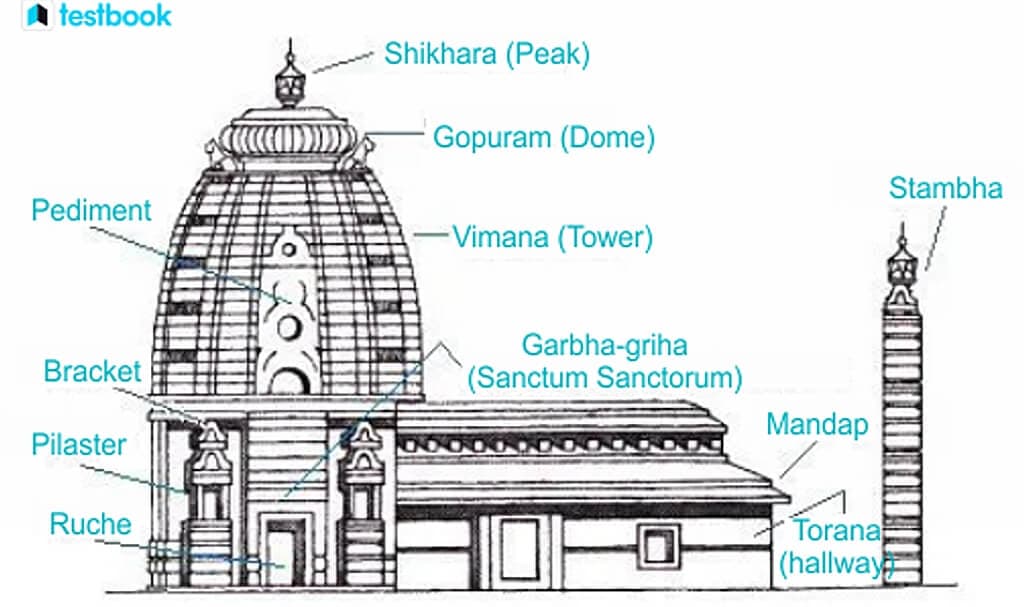Nagara Style of Temple Carving- A Northern Architectural Remembrance
- Design Blogs
Nagara Style of Temple Carving- A Northern Architectural Remembrance
Contact us
Bengaluru
Campus 1 : JD School of Design, No. 18-1, Brigade Road, Bengaluru,Karnataka – 560 001.
Campus 2 : No. 40, Swan House, 4th Cross, Residency Road, Bengaluru, Karnataka – 560001.
Goa
Musthtifund Saunstha , Near Mahalaxmi Temple,Dada Vaidya Road, Goa-403001

The Nagara style of temple architecture, a significant facet of Indian cultural heritage, showcases a rich blend of spirituality and artistic brilliance. In this exploration, we’ll unravel the intricacies of Nagara architecture, understanding its key features and the profound symbolism behind each element.
1. Origins and Evolution
1.1 Historical Roots
Tracing back to the 5th century, the Nagara style of temples originated in the northern regions of India and was first documented by the Gupta dynasty in the 5th century CE. Its evolution can be observed through various periods, each contributing unique elements to the overall aesthetic.
1.2 Influence of Vastu Shastra
At its core, the Nagara style of temple architecture is deeply rooted in Vastu Shastra, an ancient Indian architectural science. This influence is evident in the meticulous planning and alignment of the temples. Nagara temples are built on a raised plinth, with the garbha griha (sanctum sanctorum) — where the idol of the deity rests — the most sacred part of the temple. Towering over the garbha griha is the shikhara (literally ‘mountain peak’), the most distinguishable aspect of Nagara-style temples.
Major Features of Nagara Style of Architecture or North India Temple Style Some of the major features of North Indian temple architecture include the following:
- Shikhara: The shikhara is the tallest tower of the temple. It is typically pyramidal and tapers towards the top. It is topped by a bulbous finial called a kalasha.
- Plan: Nagara temples are typically built on a square or rectangular plan. The shikhara is located in the center. The temple may also have many smaller towers, called mukhamandapas, located around the shikhara.
- Walls: The walls of Nagara temples are typically made of stone or brick. They are decorated with sculptures and reliefs. The walls may also have a series of windows, which allow light to enter the temple.
- Pillars: The pillars of Nagara temples are typically carved with intricate designs. They are topped by capitals that support the roof.
- Toranas:The toranas are the gateways to the temple. They are typically made of stone or wood and are decorated with sculptures and reliefs.
- Mandapa:The mandapa is the main hall of the temple. It is where the devotees gather to worship the deity. Pillars typically support the mandapa and have a high ceiling.
- Garbhagriha: The garbhagriha is the innermost sanctum of the temple, where the deity is enshrined. It is a small, dark room that is only accessible to the priests.
The Nagara style of temple architecture stands as a testament to India’s rich cultural and spiritual legacy. Its intricate design, symbolic elements, and regional variations contribute to a vibrant architectural heritage that continues to captivate and inspire. As we explore these temples, we not only witness architectural marvels but also delve into the profound spiritual journey embedded in every stone and sculpture.
There are a few examples as well:
1. Kandariya Mahadeva Temple, Khajuraho
Location: Khajuraho, Madhya Pradesh The Kandariya Mahadeva Temple is a masterpiece of Nagara architecture dating back to the 11th century. Its towering Shikhara, adorned with intricately carved sculptures, is a visual symphony. The temple’s exterior features Devakoshtas showcasing various deities, while the interior boasts a Garbhagriha dedicated to Lord Shiva. The erotic sculptures, controversial yet artistically profound, add a unique dimension to this UNESCO World Heritage Site.

2. Jagdish Temple, Udaipur
Location: Udaipur, Rajasthan The Jagdish Temple, built in the mid-17th century, exemplifies the Nagara architecture style in the royal city of Udaipur. Its three-tiered Shikhara, rising gracefully above the cityscape, captures the essence of Rajput architecture. The Mandapa, with its ornate pillars and carved ceiling, serves as a picturesque setting for religious ceremonies. Devotees flock to the Garbhagriha, dedicated to Lord Vishnu, where the deity resides in divine splendor.

3. Laxminarayan Temple, Bhopal
Location: Bhopal, Madhya Pradesh A relatively modern example, the Laxminarayan Temple in Bhopal showcases the adaptability of Nagara architecture. Built in the 20th century, it seamlessly blends traditional design elements with contemporary aesthetics. The temple’s Shikhara, though less towering, is adorned with intricate carvings, and the Mandapa provides a serene space for prayers and gatherings. This temple reflects the enduring appeal of Nagara style across different periods.

4. Baijnath Temple, Himachal Pradesh
Location: Baijnath, Himachal Pradesh Nestled in the scenic landscapes of Himachal Pradesh, the Baijnath Temple is a significant Nagara-style shrine dedicated to Lord Shiva. The temple, believed to be over 800 years old, boasts a tall and slender Shikhara with intricate carvings. The simplicity of its design and the serene surroundings make it a spiritual retreat. Baijnath Temple exemplifies how Nagara architecture has found its place in diverse geographical and cultural settings.

Indian Archeology is a glossary for every aspiring interior designer, and here at JD Institute of Designing, you have a platform to explore more to learn and gain more. Just click on our websiteIndian Archeology is a glossary for every aspiring interior designer, and here at JD Institute of Designing, you have a platform to explore more to learn and gain more. Just click on our website Indian Archeology is a glossary for every aspiring interior designer, and here at JD Institute of Designing, you have a platform to explore more to learn and gain more. Just click on our website https://www.jdinstitute.edu.in/ and apply for admission!

